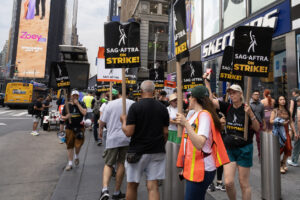How comms helps bring diverse talent to the space industry
The Aerospace Corporation launched an industry-wide push to benchmark diverse talent through comms.

Each year, leaders from space companies gather at the Space Symposium to discuss, address and plan what the future of space looks like. While it’s always an exciting event, this past year was different. The Aerospace Corporation, a federally funded research and development center that serves as technical advisor to the US Space Enterprise, unveiled the first-year results of its Space Workforce 2030 program.
The Aerospace Corporation was first established by Congress in 1960 so the nation would have an organization to provide research and analysis for national security in space that was free from conflicting interests and shareholder accountability. Because of this, the organization is in a unique position to collect and aggregate data on what opportunities lie ahead.
A big one: Creating a pipeline for talented people who don’t come from privileged backgrounds to join the space industry.
This is the specific focus of Space Workforce 2030, which starts for students K-12 and taps into existing STEM programs to create interns who can go on to have successful space careers.
“The space industry, if you look at the numbers, is growing leaps and bounds,” explains Sabrina Steele, executive director of corporate communications and public affairs at The Aerospace Corporation. “Not just national security, but globally, the number of spacefaring nations and the number of jobs. The impetus for the space workforce is that we have historically gone to the top engineering programs, which have historically not had the most diverse populations. We’ve acknowledged that we need diversity of opinion for innovation, diversity of backgrounds, diversity of learning, so we’re helping to grow the pipeline.”
Steele’s team stood this effort up at the Space Symposium 2023, focusing on engaging 30 CEOs from big space companies. They announced the impacts of this first year with a pledge for partner companies to commit to DE&I work in the industry.
“The CEOs are holding themselves accountable, and our companies accountable, for improvements in the women and people of color on the technical staff,” said Steele,
30 companies took the pledge including Boeing, Lockheed, Raytheon, Northrop and others. One hundred percent of companies participated in a baseline for the first year and 100% participated in the second year, too. The initiative collected data on eight measures, and six of the eight showed statistically significant improvements.
“We were not expecting that,” said Steele. “It’s good news. But there’s still a lot of really important work to do.”
The impact of affirmative action bans
When asked how the recent SCOTUS ruling on affirmative action may impact this work, Steele noted that the company is based in California, a state that eliminated affirmative action for state and government institutions with the passing of Proposition 209 in 1996. But she acknowledged that the federal ruling still impacts the industry overall, including Areospace’s 22 locations across the country.
As Aerospace was benchmarking its head of general counsel reached out to all his counterparts, its HR leader reached out to hers, Steele reached out to the communication functions to coordinate strategy around the decision.
“We’re paying attention,” she said. “We’re not backing down. It really tells us that we need to pay more attention than ever to growing the pipeline. What we really talk about from a diversity of experience (lens) is socioeconomic factors, that’s informative. Most states have a range of populations and needs.”
Aerospace focuses on intentionally helping first-generation students be prepared for a technical degree from when they’re in K-3, then middle and high school.
“That investment in time and partners and locations right around our workplace so we can bring them in and be interactive with them? That yields great results,” said Steele. “That works.”
More than 300 national space interns came through the Space Workforce 2030 effort. They’re across the 30 companies, across the U.S. and it’s a great start to the goal of 3,000. Even better is the conversion rate bringing them right into full-time jobs.
“We’re really trying to help them see themselves in the space ecosystem,” Steele said.
The mixternal element
Well before Space Workforce 2030 began, Aerospace created the Dr. Wanda Austin Scholarship. It was named for Aero’s prior CEO, a Black woman and first-generation leader who grew up in the Bronx. Dr. Austin had a family who supported her and great mentors along the way. When she retired, Aerospace set up a scholarship for first-generation students in her honor.
Now eight years in, Aerospace is celebrating her legacy, and the scholarship, with media partners. In one example, Telemundo came out to HQ and brought four Latino interns, along with four in their early to mid-career, who were interviewed in Spanish about the excitement of space and the power of networking and mentoring. The visit featured the program’s very first scholar, Heydy Arias, who shared how she benefited from the paid internship and the scholarship. With the internship, she made her expense money for college. Arias is now a math teacher in South Central LA impacting hundreds of kids.
This is just one of the external strategies for keeping the momentum of this work up past the one-year mark. Others, like the push to get the word out on the national space intern program, involved both internal and external efforts. Steele’s team understood the importance of making this initiative stand out to potential applicants, and of getting them to understand that this forum for national space interns is the equivalent of a common application process for college acceptance.
But delivering that message took coordination. At Aerospace, this meant working on a strategy of continuing to reach regular interns while carving out and intentionally targeting national space interns within that group. The team did geo-targeting, targeted social media around certain schools with underrepresented, underserved populations. It doubled down on Historically Black Colleges and Universities (HBCUs) that they already partnered with and ensured this push wasn’t conflicting with other efforts.
“What can we do within a program that may challenge our partner companies to do the same?” asked Steele. The answer: Aerospace gave its top employee recruiters a toolkit to reach out to the interns and communities they are already volunteering with. It included copy and assets for LinkedIn, Twitter and more. It also empowered partners they already had on the technical side, like hiring managers, to get that out.
“You could tell where it was effective because we clearly see the graduates coming from the strong partners,” Steele said.
The ‘AHA’ moment and what’s next
Beyond the benefits of positively impacting the space industry, this initiative also brought recognition to the Space Workforce 2030 team. At Aerospace’s Corporate Achievement Awards 2023, The Trustee’s Distinguished Achievement Award went to team members Via Van Liew, Alison Bauerlein, Sandy Yonemoto, Angela Couture and Steele. They were specifically recognized for getting other industry leaders to commit to share workforce data, exchange best practices, and hold themselves accountable by reporting out on their collective progress annually at the Space Symposium.
The win has Steele wondering what’s next for this work: How does the team scale and build upon it? How do they do it more intentionally and keep the strategies fresh? She acknowledges that interns are often most active on LinkedIn, so the team decided to do less on X (formerly Twitter). They’re going to partner companies with SEO best practices. And it’s all part of the accountability process.
“That’s the ‘AHA,’” Said Steele. “We were stood up over 60 years ago to be this neutral, objective, trusted, technical continuity for space. Working under the future of space to make sure we do it right. Things are innovating and we’ve got a pipeline to work in and sustain it.”
The stakes are as big as they come: Space Workforce 2030 challenges the assumption that space exploration, and colonization, is ultimately just for the privileged few. It challenges the narrative that a bunch of billionaires ruined this planet and are just moving the problems that they created to another one.
“The generation that’s coming in is so committed to the environment and wants to bring that to space with the knowledge we have,” Steele said. “There’s an environmental responsibility that says we’re starting with a clean slate. How do we do this? It’s not about putting trash in space—it’s honoring space.”
Aerospace, its comms team included, continues to do its part by staying true to its mission.
“There’s going to be things that happen in our society,” said Steele, “and we just have to stay true to having the best. The best employees, the top talent and the different perspectives that you have on the table. When people haven’t felt empowered to speak up, things fail. That’s big dollars, it’s lives.”
“We’re literally moving into spaceports that gravitate around the Earth, colonizing the Moon and Mars. And that new frontier is going to be diverse. It’s going to be all cultures, all nations.”
Justin Joffe is the editor-in-chief at Ragan Communications. Before joining Ragan, Joffe worked as a journalist and communications writer specializing in the arts and culture, media and technology, PR and ad tech beats. His writing has appeared in several publications including Vulture, Newsweek, Vice, Relix, Flaunt, and many more.







